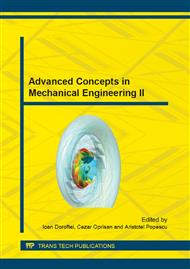p.349
p.353
p.359
p.365
p.371
p.377
p.383
p.389
p.395
Active Pulse Thermography Applied to Defect Detection in Bioceramic Materials
Abstract:
The present paper presents a non-destructive technique (NDT) using active pulse infrared thermography with a thermal excitation consisting in two photographic flash laps controlled by a signal generator. For this work we used two bioceramics samples, having the same size, 15, 30 mm diameter and 3, 75 mm thickness. A non-defect sample was used as the basis to demonstrate the temperature differences in the defected zone between the healthy and the defective one. In the second sample was created an internal defect. The main advantage of this method represents its possibility to detect the internal defects in bioceramic materials, the method being more reliable then the microscopic method. Other two advantages of this method are represented bythe rapidity of testing and the maintenance of material properties after the thermal excitation.
Info:
Periodical:
Pages:
371-376
Citation:
Online since:
October 2014
Keywords:
Price:
Сopyright:
© 2014 Trans Tech Publications Ltd. All Rights Reserved
Share:
Citation:


